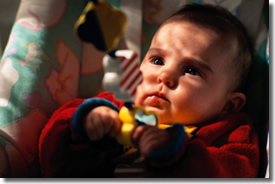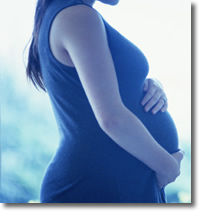Fetal Alcohol Exposure and the Brain
Download PDF Version What is PDF?
Source: Alcohol Alert, The Journal of the National Institute on Alcohol Abuse and Alcoholism,
No. 50, 2000
Public Domain
Table of Contents (TOC)
IntroductionChapter 1: Specific Cognitive and Behavioral Impairments
Chapter 2: Effects on Brain Structure
Chapter 3: Potential Causal Mechanisms
Chapter 4: Effect of Maternal Drinking Levels
Chapter 5: Fetal Exposure and the Brain-A Commentary
References
 Nearly 30 years ago, scientists first coined the term "fetal alcohol syndrome" (FAS) to describe a pattern of birth defects found in children of mothers who consumed alcohol during pregnancy.1, 2 Today, FAS remains the leading known preventable cause of mental retardation.3 Behavioral and neurological problems associated with prenatal alcohol exposure may lead to poor academic performance as well as legal and employment difficulties in adolescence and adulthood.4 Despite attempts to increase public awareness of the risks involved, increasing numbers of women are drinking during pregnancy.5 This bulletin updates Alcohol Alert No. 13 with new data on the prevalence and nature of the neurobehavioral problems associated with alcohol use during pregnancy, explores potential mechanisms underlying alcohol-induced damage to the developing brain, and discusses prevention research.
Nearly 30 years ago, scientists first coined the term "fetal alcohol syndrome" (FAS) to describe a pattern of birth defects found in children of mothers who consumed alcohol during pregnancy.1, 2 Today, FAS remains the leading known preventable cause of mental retardation.3 Behavioral and neurological problems associated with prenatal alcohol exposure may lead to poor academic performance as well as legal and employment difficulties in adolescence and adulthood.4 Despite attempts to increase public awareness of the risks involved, increasing numbers of women are drinking during pregnancy.5 This bulletin updates Alcohol Alert No. 13 with new data on the prevalence and nature of the neurobehavioral problems associated with alcohol use during pregnancy, explores potential mechanisms underlying alcohol-induced damage to the developing brain, and discusses prevention research.
Definitions and Incidence
FAS is defined by four criteria: maternal drinking during pregnancy; a characteristic pattern of facial abnormalities; growth retardation; and brain damage, which often is manifested by intellectual difficulties or behavioral problems.3 When signs of brain damage appear following fetal alcohol exposure in the absence of other indications of FAS, the condition is termed "alcohol-related neurodevelopmental disorder" (ARND).3
Investigators have used both passive and active methods to determine the overall incidence of FAS and ARND. The passive approach uses data collected from existing medical records, which are often based on information recorded at birth. However, the criteria required for these diagnoses may not be apparent at birth and often develop gradually from infancy through the first few years of grade school.6 In the active approach, investigators use a defined set of diagnostic criteria to screen all members of a selected population for FAS and other alcohol-related problems. Although both strategies have limitations, active ascertainment provides more accurate prevalence data for the study population, especially if children are examined at elementary school age.3 For example, a comprehensive survey of 992 first-grade students in 12 of the 13 elementary schools in a South African community revealed an FAS incidence of more than 40 FAS cases per 1,000 births among children ages 5 to 9.7 In the United States, a preliminary active ascertainment of FAS in a single county in Washington State yielded a minimum estimate of 3.1 per 1,000 first-grade students.8 By comparison, passive estimates of FAS rates range from 0.33 to 3 infants per 1,000 births.3,9
 The broad range of cognitive and behavioral disabilities associated with prenatal alcohol exposure was attributed by many researchers to a generalized impairment of mental functioning. However, recent studies on FAS and ARND reveal that specific neurobehavioral functions are consistently impaired, whereas others are spared.10, 11, 12, 13 Thus, the outlook for persons diagnosed with FAS or ARND should not be considered hopeless.14, 15 Some specific neurobehavioral impairments associated with prenatal alcohol exposure are discussed below.
The broad range of cognitive and behavioral disabilities associated with prenatal alcohol exposure was attributed by many researchers to a generalized impairment of mental functioning. However, recent studies on FAS and ARND reveal that specific neurobehavioral functions are consistently impaired, whereas others are spared.10, 11, 12, 13 Thus, the outlook for persons diagnosed with FAS or ARND should not be considered hopeless.14, 15 Some specific neurobehavioral impairments associated with prenatal alcohol exposure are discussed below.
Verbal Learning. Children prenatally exposed to alcohol exhibit a variety of problems with language and memory.3, 10 For example, Mattson and colleagues11 found that children with FAS ages 5 to 16 learned fewer words compared with a group of children of comparable mental age who did not have FAS. However, both groups demonstrated equal ability to recall information learned previously. These findings indicate that FAS-related learning problems occur during the initial stages of memory formation (i.e., encoding). Once encoded, verbal information can be retained and recalled, subject to normal rates of forgetting.11, 13 Clinically, this pattern helps distinguish FAS from Down’s syndrome, in which learning and recall are equally impaired.16
Visual-Spatial Learning. Children of mothers who drank heavily during pregnancy perform poorly on tasks that involve learning spatial relationships among objects. In one experiment, groups of children with and without FAS were equal in their ability to recall common, small household and schoolroom objects (e.g., a paper clip or spoon) that had been placed within sight on a table and then removed.17 However, children with FAS had greater difficulty subsequently restoring the objects to their original positions on the table.17
Attention. Attention problems have been considered a hallmark of prenatal alcohol exposure.13 Consequently, FAS is often incorrectly diagnosed as attention deficit hyperactivity disorder (ADHD) and treated inappropriately.18 Coles and colleagues18 found that children with ADHD exhibited difficulty focusing and sustaining attention over time. In contrast, children who were exposed to alcohol prenatally were able to focus and maintain attention, but displayed difficulty in shifting attention from one task to another (i.e., set shifting).18
 Reaction Time. Individual differences in intelligence are based in part on how quickly the brain processes information. Prenatal alcohol exposure has been associated with slower, less efficient information processing in school-age children .19 Jacobson and colleagues20 found similar problems in children as young as 6 1/2 months. These researchers recorded the eye movements of infants reacting to the appearance, movement, and disappearance of a repeating sequence of geometric designs and colors on a video screen. Maternal drinking during pregnancy was related to longer reaction times among the children, suggesting slower, less efficient information processing.20
Reaction Time. Individual differences in intelligence are based in part on how quickly the brain processes information. Prenatal alcohol exposure has been associated with slower, less efficient information processing in school-age children .19 Jacobson and colleagues20 found similar problems in children as young as 6 1/2 months. These researchers recorded the eye movements of infants reacting to the appearance, movement, and disappearance of a repeating sequence of geometric designs and colors on a video screen. Maternal drinking during pregnancy was related to longer reaction times among the children, suggesting slower, less efficient information processing.20
Executive Functions. Important deficits in FAS involve executive functions (i.e., activities that require abstract thinking, such as planning and organizing). For example, problems with set shifting are common, as noted earlier. Children prenatally exposed to alcohol respond poorly when asked to switch from naming animals to naming types of furniture, and then back to naming animals.21 They also have difficulty abandoning demonstrably ineffective strategies when approaching problem-solving tasks,21, 22 a type of behavioral inflexibility referred to as perseveration. Perseveration and impaired set shifting are consistent with distractibility and impulsivity, factors that at least theoretically might contribute to attention and learning problems.11, 22, 23
The behavioral and cognitive impairments associated with FAS reflect underlying structural or functional changes in the brain.24 Techniques for viewing the living brain, such as magnetic resonance imaging (MRI), reveal reduced overall brain size in persons with FAS and disproportionate reductions in the size of specific brain structures.24
One such area is the deep-brain structure called the basal ganglia.25, 26 Damage to the basal ganglia impairs spatial memory and set shifting in animals26, 27 and various cognitive processes in humans.28 Another common finding is reduced size of the cerebellum,25, 29 a structure involved in balance, gait, coordination, and cognition.30 Finally, prenatal alcohol exposure is the major cause of impaired development30 or complete absence30, 31 of the corpus callosum, a band of nerve fibers that forms the major communication link between the right and left halves of the brain. Approximately 7 percent of children with FAS may lack a corpus callosum, an incidence rate 20 times higher than that in the general population.30
 The mechanisms that underlie alcohol-induced fetal brain damage have been studied in experimental animals and in nerve cells (i.e., neurons) grown in culture.32 Within the fetus, embryonic cells destined to become brain neurons grow in number, move to their ultimate locations, and mature into a wide variety of functionally distinct neuronal cell types, eventually forming connections with other brain cells in a predetermined pattern. Alcohol metabolism is associated with increased susceptibility to cell damage caused by potentially harmful substances called free radicals. Free radical damage can kill sensitive populations of brain cells at critical times of development in the first trimester of pregnancy.33, 34 Other animal experiments suggest that the third trimester may also represent a particularly sensitive period for brain cell damage associated with FAS.35
The mechanisms that underlie alcohol-induced fetal brain damage have been studied in experimental animals and in nerve cells (i.e., neurons) grown in culture.32 Within the fetus, embryonic cells destined to become brain neurons grow in number, move to their ultimate locations, and mature into a wide variety of functionally distinct neuronal cell types, eventually forming connections with other brain cells in a predetermined pattern. Alcohol metabolism is associated with increased susceptibility to cell damage caused by potentially harmful substances called free radicals. Free radical damage can kill sensitive populations of brain cells at critical times of development in the first trimester of pregnancy.33, 34 Other animal experiments suggest that the third trimester may also represent a particularly sensitive period for brain cell damage associated with FAS.35
Alcohol or its metabolic breakdown products can also interfere with brain development by altering the production or function of natural regulatory substances that help promote the orderly growth and differentiation of neurons.32 Research using animals or cell cultures show that many of alcohol’s adverse effects on brain cells can be prevented by treatments aimed at restoring the balance of regulatory substances upset by alcohol.36,37 Promising results have also been obtained in similar experiments by administering substances (i.e., antioxidants) that help protect cells against free radical-induced cell damage.38 This is only one of several potential mechanisms that may contribute to alcohol-related fetal injury. Further research is needed to determine if such an approach might prove both effective and safe in humans during pregnancy.
 The minimum quantity of alcohol required to produce adverse fetal consequences is unknown.22 Clinically significant deficits are not common in children whose mothers drank less than approximately five drinks per occasion once per week.39 However, vulnerability to a given alcohol level during pregnancy varies markedly from person to person, possibly reflecting genetic factors, nutritional status, environmental factors, co-occurring diseases, and maternal age.40 Prospects for Prevention FAS and ARND could be completely eliminated if pregnant women did not consume alcohol. Therefore, recent FAS prevention research has focused on finding and treating women who drink during pregnancy. For example, TWEAK41 -a brief questionnaire for assessing alcohol problems in women-shows promise as a screening instrument for identifying risk drinking by pregnant women.42
The minimum quantity of alcohol required to produce adverse fetal consequences is unknown.22 Clinically significant deficits are not common in children whose mothers drank less than approximately five drinks per occasion once per week.39 However, vulnerability to a given alcohol level during pregnancy varies markedly from person to person, possibly reflecting genetic factors, nutritional status, environmental factors, co-occurring diseases, and maternal age.40 Prospects for Prevention FAS and ARND could be completely eliminated if pregnant women did not consume alcohol. Therefore, recent FAS prevention research has focused on finding and treating women who drink during pregnancy. For example, TWEAK41 -a brief questionnaire for assessing alcohol problems in women-shows promise as a screening instrument for identifying risk drinking by pregnant women.42
Pregnant women who are consuming alcohol but are not "problem" drinkers may decrease their drinking level following such an assessment without subsequent treatment.43 An overall decline in alcohol consumption has also been noted among pregnant women following a brief intervention, which can be conducted by a primary care provider.43 Such sessions may include a discussion of the risks of maternal drinking and suggested alternatives to alcohol use. Pregnant women with higher drinking levels may benefit from a 1-hour motivational interview focusing on the health of the unborn child .44 Women who are alcohol dependent require intensive alcoholism treatment.44
By NIAAA Director Enoch Gordis, M.D.
Since our last Alcohol Alert on FAS, published in 1991, the pace of research on the effects of alcohol on the fetus has accelerated appreciably. Progress has been made most notably in research aimed at understanding the basic mechanisms involved in the neurobiological damage that occurs in alcohol-exposed fetuses and in developing potential new therapies to prevent that damage. We also have increased our understanding of the long-term cognitive and physical challenges of children who were exposed to alcohol in the womb. As a result, clinicians and behavioral scientists are finding ways to identify these children early and ways to help.
Despite the many gains in knowledge, we still do not know if there is a "safe" dose of alcohol that can be consumed by pregnant women without risking damage to their unborn children. Until such a safe dose, if it exists, can be determined, the only responsible advice to women who wish to become pregnant and to those who are pregnant is to avoid alcohol use entirely. Unfortunately, many women continue to drink during pregnancy. Furthermore, many of the women who continue to drink during pregnancy are at highest risk for having children with fetal alcohol syndrome and related problems. Thus, finding potent new ways to reach populations at risk and to influence changes in their behavior remains a challenge for alcohol research.
NOTE:
NIAAA has developed two new guides to provide clinicians with office-based screening and intervention protocols for alcohol-related birth defects: Identification of At-Risk Drinking and Intervention with Women of Childbearing Age (NIH Pub. No. 99-4368) and Identification and Care of Fetal Alcohol-Exposed Children (NIH Pub. No. 99-4369). Both can be ordered through NIAAA’s Web site at http://www.niaaa.nih.gov (from the homepage, click on "Publications"); by fax at (202) 842-0418; or by writing to NIAAA Publications Distribution Center, P.O. Box 10686, Rockville, MD 20849-0686. Please specify the appropriate publication number(s) when ordering.
(1) Lemoine, P. ; Harousseau, H.; Borteyru, J.P.; and Menuet, J.C. Les enfants de parents alcooliques: Anomalies observées à propos de 127 cas. Ouest Med 21:476-482, 1968.
(2) Jones, K.L. , and Smith, D.W. Recognition of the fetal alcohol syndrome in early infancy. Lancet 2:999-1001, 1973.
(3) Stratton, K. ; Howe, C.; and Battaglia, F., eds. Fetal Alcohol Syndrome: Diagnosis, Epidemiology, Prevention, and Treatment. Washington, D.C.: National Academy Press, 1996.
(4) Thomas, S.E. ; Kelly, S.J.; Mattson, S.N.; and Riley, E.P. Comparison of social abilities of children with fetal alcohol syndrome to those of children with similar IQ scores and normal controls. Alcohol Clin Exp Res 22(2):528-533, 1998.
(5) Ebrahim, S.H. ; Diekman, S.T.; Floyd, R.L.; and Decoufle, P. Comparison of binge drinking among pregnant and nonpregnant women, United States, 1991-1995. Am J Obstet Gynecol 180(1, Part 1):1-7, 1999.
(6) Aase, J.M. Clinical recognition of FAS: Difficulties of detection and diagnosis. Alcohol Health Res World 18(1):5-9, 1994.
(7) May, P.A. ; Brooke, L.; Gossage, J.P.; et al. Epidemiology of fetal alcohol syndrome in a South African community in the Western Cape Province. Am J Pub Health 90(12):1905-1912, 2000.
(8) Clarren, S.K. ; Randels, S.P.; Sanderson, M.; and Fineman, R.M. Screening for fetal alcohol syndrome in primary schools: A feasibility study. Teratology 63(1):3-10, 2001.
(9) Abel, E.L. , and Sokol, R.J. A revised conservative estimate of the incidence of FAS and its economic impact. Alcoholism: Clin Exp Res 15(3):514-524, 1991.
(10) Janzen, L.A. ; Nanson, J.L.; and Block, G.W. Neuropsychological evaluation of preschoolers with fetal alcohol syndrome. Neurotoxicol Teratology 17(3):273-279, 1995.
(11) Mattson, S.N. ; Riley, E.P.; Delis, D.C.; Stern, C.; and Jones, K.L. Verbal learning and memory in children with fetal alcohol syndrome. Alcohol Clin Exp Res 20(5):810-816, 1996a.
(12) Olson, H.C. ; Feldman, J.J.; Streissguth, A.P.; Sampson, P.D.; and Bookstein, F.L. Neuropsychological deficits in adolescents with fetal alcohol syndrome: Clinical findings . Alcohol Clin Exp Res 22(9):1998-2012, 1998.
(13) Mattson, S.N. , and Riley, E.P. A review of the neurobehavioral deficits in children with fetal alcohol syndrome or prenatal exposure to alcohol. Alcohol Clin Exp Res 22(2):279-294, 1998.
(14) Mattson, S.N. ; Riley, E.P.; Gramling, L.; et al. Neuropsychological comparisons of alcohol-exposed children with or without physical features of fetal alcohol syndrome. Neuropsychology 12(1):146-153, 1998.
(15) Ernhart, C.B. ; Greene, T.; Sokol, R.J.; et al. Neonatal diagnosis of fetal alcohol syndrome: Not necessarily a hopeless prognosis. Alcohol Clin Exp Res 19(6):1550-1557, 1995.
(16) Mattson, S.N. ; Goodman, A.M.; Caine, C.; Delis, D.C.; and Riley, E.P. Executive functioning in children with heavy prenatal alcohol exposure. Alcohol Clin Exp Res 23(11):1808-1815, 1999.
(17) Uecker, A. , and Nadel, L. Spatial locations gone awry: Object and spatial memory deficits in children with fetal alcohol syndrome. Neuropsychologia 34(3):209-223, 1996.
(18) Coles, C.D. ; Platzman, K.A.; Raskind-Hood, C.L.; et al. A comparison of children affected by prenatal alcohol exposure and attention deficit, hyperactivity disorder. Alcohol Clin Exp Res 21(1):150-161, 1997.
(19) Streissguth, A.P. ; Barr, H.M.; Sampson, P.D.; et al. Attention, distraction, and reaction time at age 7 years and prenatal alcohol exposure. Neurobehav Toxicol Teratology 8(16):717-725, 1986.
(20) Jacobson, S.W. ; Jacobson, J.L.; and Sokol, R.J. Effects of fetal alcohol exposure on infant reaction time. Alcohol Clin Exp Res 18(5):1125-1132, 1994.
(21) Kodituwakku, P.W. ; Handmaker, N.S.; Cutler, S.K.; Weathersby, E.K.; and Handmaker, S.D. Specific impairments in self-regulation in children exposed to alcohol prenatally. Alcohol Clin Exp Res 19(6):1558-1564, 1995.
(22) Roebuck, T.M. ; Mattson, S.N.; and Riley, E.P. Behavioral and psychosocial profiles of alcohol-exposed children. Alcohol Clin Exp Res 23(6):1070-1076, 1999.
(23) Hunt, E. ; Streissguth, A.P.; Kerr, B.; and Olson, H.C. Mothers’ alcohol consumption during pregnancy: Effects on spatial-visual reasoning in 14-year-old children . Psychol Science 6(6):339-342, 1995.
(24) Roebuck, T.M. ; Mattson, S.N.; and Riley, E.P. A review of the neuroanatomical findings in children with fetal alcohol syndrome or prenatal exposure to alcohol. Alcohol Clin Exp Res 22(2):339-344, 1998.
(25) Mattson, S.N. ; Riley, E.P.; Jernigan, T.L.; et al. A decrease in the size of the basal ganglia following prenatal alcohol exposure: A preliminary report. Neurotoxicol Teratology 16(3):283-289, 1994.
(26) Mattson, S.N. ; Riley, E.P.; Sowell, E.R.; et al. A decrease in the size of the basal ganglia in children with fetal alcohol syndrome. Alcohol Clin Exp Res 20(6):1088-1093, 1996b.
(27) Mattson, S.N. , and Riley, E.P. Implicit and explicit memory functioning in children with heavy prenatal alcohol exposure. J Int Neuropsychol Soc 5(5):462-471, 1999.
(28) Bannister, R. Brain and Bannister’s Clinical Neurology. 7th ed. New York: Oxford University Press, 1992.
(29) Sowell, E.R. ; Jernigan, T.L.; Mattson, S.N.; et al. Abnormal development of the cerebellar vermis in children prenatally exposed to alcohol: Size reduction in lobules I-V. Alcohol Clin Exp Res 20(1):31-34, 1996.
(30) Riley, E.P. ; Mattson, S.N.; Sowell, E.R.; et al. Abnormalities of the corpus callosum in children prenatally exposed to alcohol. Alcohol Clin Exp Res 19(5):1198-1202, 1995.
(31) Swayze, II, V.W. ; Johnson, V.P.; Hanson, J.W.; et al. Magnetic resonance imaging of brain anomalies in fetal alcohol syndrome. Pediatrics 99(2):232-240, 1997.
(32) Michaelis, E.K. , and Michaelis, M.L. Cellular and molecular bases of alcohol’s teratogenic effects. Alcohol Health Res World 18(1):17-21, 1994.
(33) Cartwright, M.M. , and Smith, S.M. Increased cell death and reduced neural crest cell numbers in ethanol-exposed embryos: Partial basis for the fetal alcohol syndrome. Alcohol Clin Exp Res 19(2):378-386, 1995.
(34) Chen, S. , and Sulik, K.K. Free radicals and ethanol-induced cytotoxicity in neural crest cells. Alcohol Clin Exp Res 20(6):1071-1076, 1996.
(35) Maier, S.E. ; Chen, W.-J.A.; and West, J.R. The effects of timing and duration of alcohol exposure on development of the fetal brain. In: Abel, E.L., ed . Fetal Alcohol Syndrome: From Mechanism to Prevention. Boca Raton, Florida: CRC Press, 1996. pp. 27-50.
(36) Luo, J. ; West, J.R.; and Pantazis, N.J. Nerve growth factor and basic fibroblast growth factor protect rat cerebellar granule cells in culture against ethanol-induced cell death. Alcohol Clin Exp Res 21(6):1108-1120, 1997.
(37) Tajuddin, N.F. , and Druse, M.J. In utero ethanol exposure decreased the density of serotonin neurons: Maternal ipsapirone treatment exerted a protective effect. Del Brain Res 117(1):91-97, 1999.
(38) Heaton, M.B. ; Mitchell, J.J.; and Paiva, M. Amelioration of ethanol-induced neurotoxicity in the neonatal rat central nervous system by antioxidant therapy. Alcohol Clin Exp Res 24(4):512-518, 2000.
(39) Jacobson, J.L. , and Jacobson, S.W. Drinking moderately and pregnancy: Effects on child development. Alcohol Res Health 23(1):25-30, 1999.
(40) Abel, E.L. , and Hannigan, J.H. Maternal risk factors in fetal alcohol syndrome: Provocative and permissive influences. Neurotoxicol Teratology 17(4):445-462, 1995.
(41) Russell, M. New assessment tools for risk drinking during pregnancy: T-ACE, TWEAK, and others. Alcohol Health Res World 18(1):55-61, 1994.
(42) Chang, G. ; Wilkins-Haug, L.; Berman, S.; and Goetz, M.A. The TWEAK: Application in a prenatal setting. J Stud Alcohol 60(3):306-309, 1999a.
(43) Chang, G. ; Wilkins-Haug, L.; Berman, S.; and Goetz, M.A. Brief intervention for alcohol use in pregnancy: A randomized trial. Addict 94(10):1499-1508, 1999b.
(44) Handmaker, N.S. ; Miller, W.R.; and Manicke, M. Findings of a pilot study of motivational interviewing with pregnant drinkers. J Stud Alcohol 60(2):285-287, 1999.


